Guilin is a prefecture-level city, located in the Guangxi Zhuang Autonomous Region of China, it is known for its stunning natural scenery and dramatic karst topography. The city is named after the fragrant osmanthus trees (Guilin means “Forest of Sweet Osmanthus”) that line its streets. Guilin’s stunning landscapes has inspired poets and artists for centuries, making it a popular destination for travelers seeking natural beauty and cultural richness.
Yangshuo is a county under the jurisdiction of Guilin, it is a smaller town located about 65 kilometers south of Guilin. Known for its breathtaking scenery, outdoor activities, and vibrant backpacker scene, Yangshuo offers a more laid-back and intimate experience compared to the bustling city of Guilin. The town is surrounded by limestone karst peaks, lush green fields, and the serene Li River, making it a haven for nature lovers and adventure seekers.
Let’s see what to visit and Do in Guilin and Yangshuo.
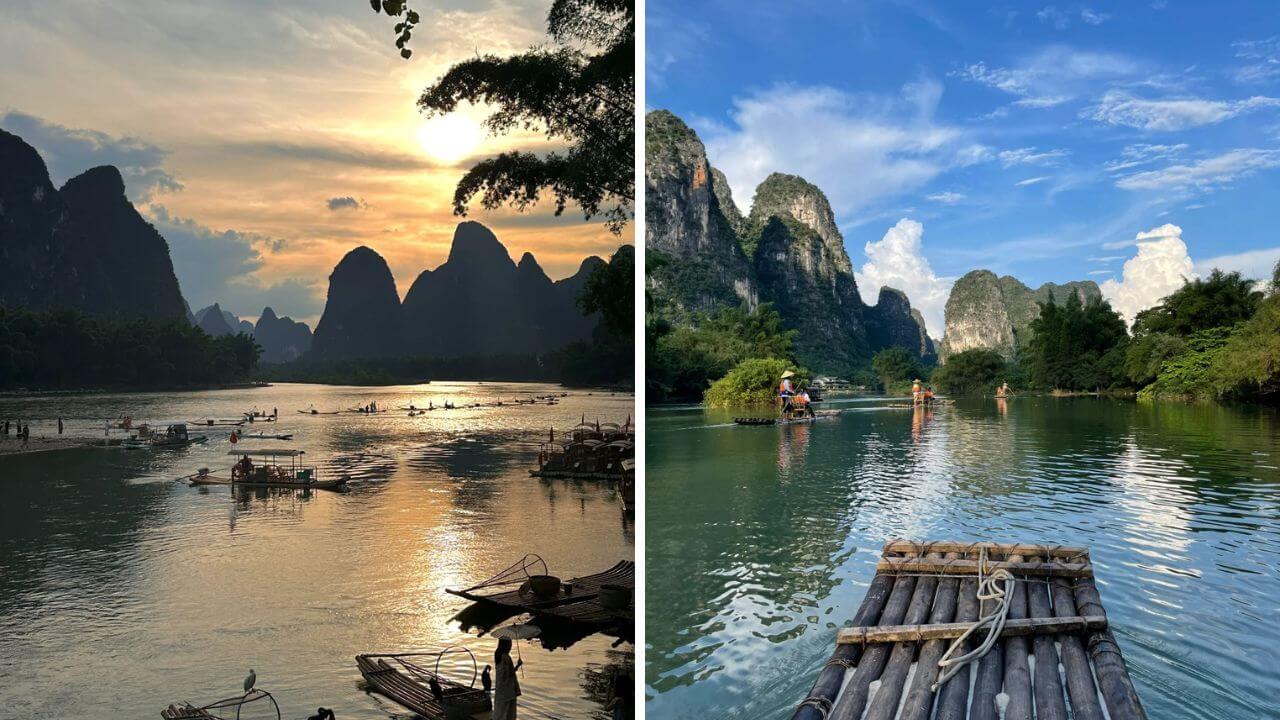
Li River Cruise
One of the most popular activities in Guilin is a cruise along the Li River which offers stunning views of the karst landscape. The journey from Guilin to Yangshuo is particularly famous for its picturesque scenery, including the iconic scene depicted on the back of the 20 yuan note.
Facts about the Li River Cruise
- Location: The Li River flows from Guilin to Yangshuo in Guangxi, China, covering the most scenic 52 kilometers between these towns.
- Scenery: stunning karst landscape, highlights include Nine Horses Fresco Hill, Yellow Cloth Shoal, and Xingping Fishing Village.
- Duration: The cruise typically lasts 4-5 hours.
- Boats: Options include larger tourist boats with amenities and smaller traditional bamboo rafts.
- Best Time to Visit: Spring (April to June) and autumn (September to October) offer the best weather and river conditions.
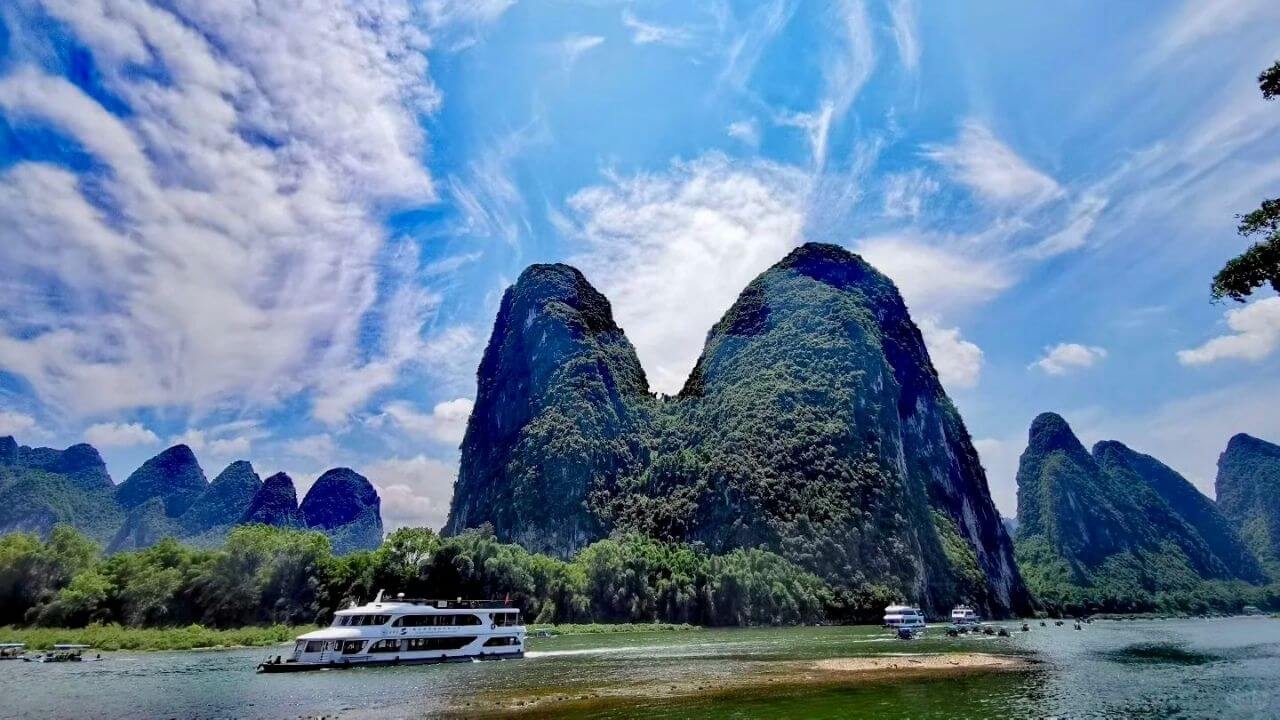
Highlights of the Li River Cruise
A Li River cruise is one of the most scenic and memorable experiences in China, offering breathtaking views of the country’s natural beauty. Here are the key highlights of the journey:
Karst Mountains
The cruise takes you through stunning karst landscapes, with dramatic limestone peaks rising sharply from the water. These unique formations, often shrouded in mist, create an otherworldly atmosphere and have inspired countless poets and artists.
Nine Horses Fresco Hill:
One of the most famous sights along the Li River, this cliffside features a natural pattern resembling nine horses. Local legends and stories add to the mystique of this formation, making it a must-see along the cruise.
Xingping Ancient Town:
As the cruise approaches Xingping, you’ll pass by this well-preserved ancient town. The area is known for its historical charm and is often depicted on Chinese currency, making it an iconic spot on the journey.
Reflection of Yellow Cloth Shoal:
This tranquil stretch of water is renowned for its crystal-clear reflections of the surrounding mountains. The perfect mirror image of the peaks on the water creates a stunning and peaceful sight that is often considered one of the most beautiful views on the Li River.
Water Buffalo and Cormorant Fishermen:
Along the way, you’ll likely spot traditional cormorant fishermen and water buffalo grazing along the riverbanks. These scenes provide a glimpse into the rural life that has remained unchanged for centuries, adding a cultural element to the natural beauty of the cruise.
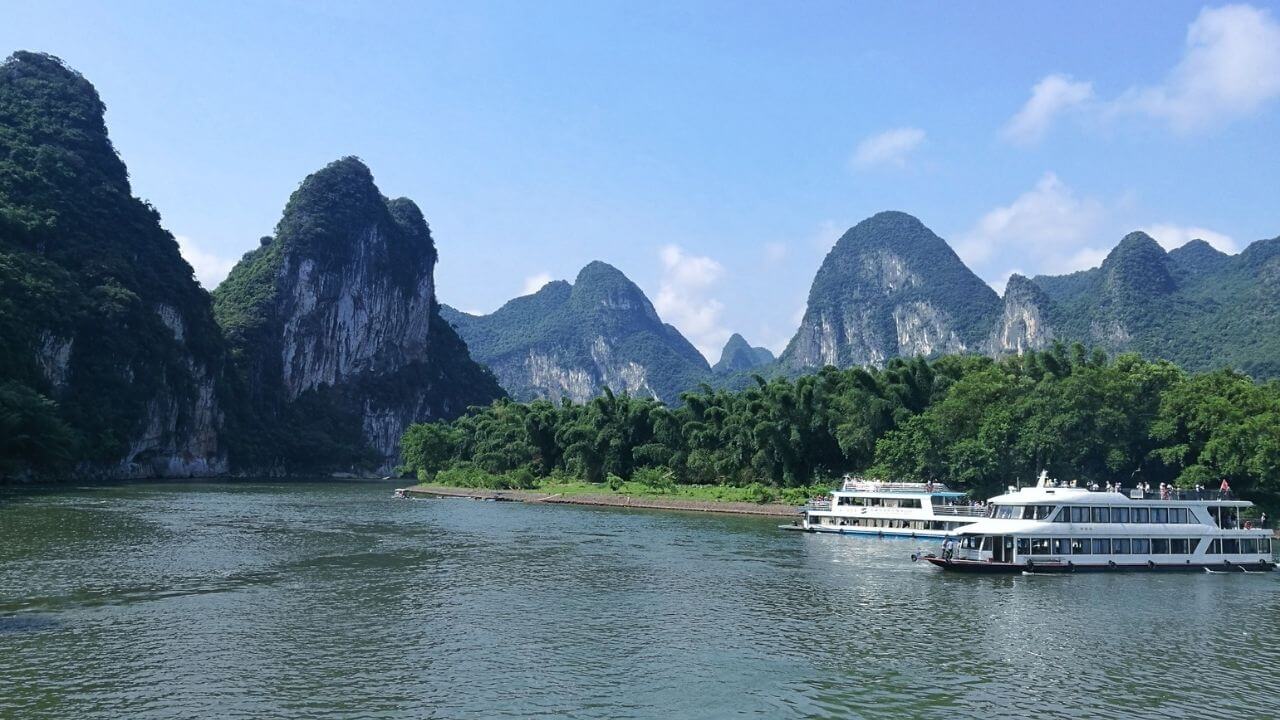
Mural Hill:
Another captivating sight is Mural Hill, named for the intricate patterns on its face that resemble a traditional Chinese painting. The vivid imagery of trees, mountains, and animals etched into the cliffside draws the attention of all who pass by.
Crowded River Markets:
As you cruise past small riverside villages, you’ll see bustling local markets and boats carrying goods along the river. These lively scenes add a vibrant, human touch to the otherwise serene landscape.
Arrival in Yangshuo:
The cruise typically ends in Yangshuo, a town renowned for its relaxed atmosphere and picturesque surroundings. The town’s charming streets, lined with cafes and shops, provide a perfect conclusion to the cruise and a chance to explore more of the region.
Tips for the Li River Cruise
Booking: Reserve your cruise in advance, especially during peak seasons.
Seating: Arrive early to secure a good seat for the best views.
Clothing: Wear comfortable clothes and bring a light jacket; it can be cool on the river.
Photography: Bring a camera with a good zoom lens to capture the scenic views.
Food and Drink: Bring snacks and drinks, as meal quality on board can vary.
Weather Check: Check the forecast; heavy rain can affect visibility and cruise schedules.
Explore Yangshuo: After the cruise, visit West Street, Moon Hill, and the Yulong River for more activities and local culture.
Reed Flute Cave
This natural limestone cave is filled with impressive stalactites, stalagmites, and rock formations, all illuminated by colorful lights. The cave is named after the reeds growing outside, which can be made into flutes.
- Location: Guilin, Guangxi Province
- Length: Approximately 240 meters (790 feet)
- Age: Over 180 million years old
- Discovery: Rediscovered in modern times during the Tang Dynasty (618-907 AD)
- Features: Stalactites, stalagmites, rock formations, inscriptions
What to expect
Impressive Rock Formations
Reed Flute Cave have a variety of amazing rock formations. Once you are inside you’ll find stalactites, stalagmites, and columns that have developed over millions of years. These formations come in various shapes and sizes, with some resembling animals, plants, and other natural objects, making them truly awe-inspiring.
Colorful Illuminations
What is very spectacular in the Reed Flute Cave is the vibrant lighting system. The rock formations are beautifully illuminated with multicolored lights, enhancing their beauty and creating a magical, otherworldly atmosphere. The lights add depth and drama, making the experience mesmerizing. Also in some of the sections have also a music and light show. These shows create an enchanting experience that enhances the cave’s allure.
Inscriptions and Historical Significance
The cave walls have numerous inscriptions from the Tang Dynasty, providing a glimpse into its historical and cultural importance. Visitors can see poems and notes left by past travelers, adding an intriguing historical dimension to the visit.
Photographic Opportunities
Reed Flute Cave offers excellent opportunities for photography. The interplay of light and shadow, combined with the intricate formations, makes for stunning photos. Visitors are encouraged to bring their cameras to capture the cave’s beauty.
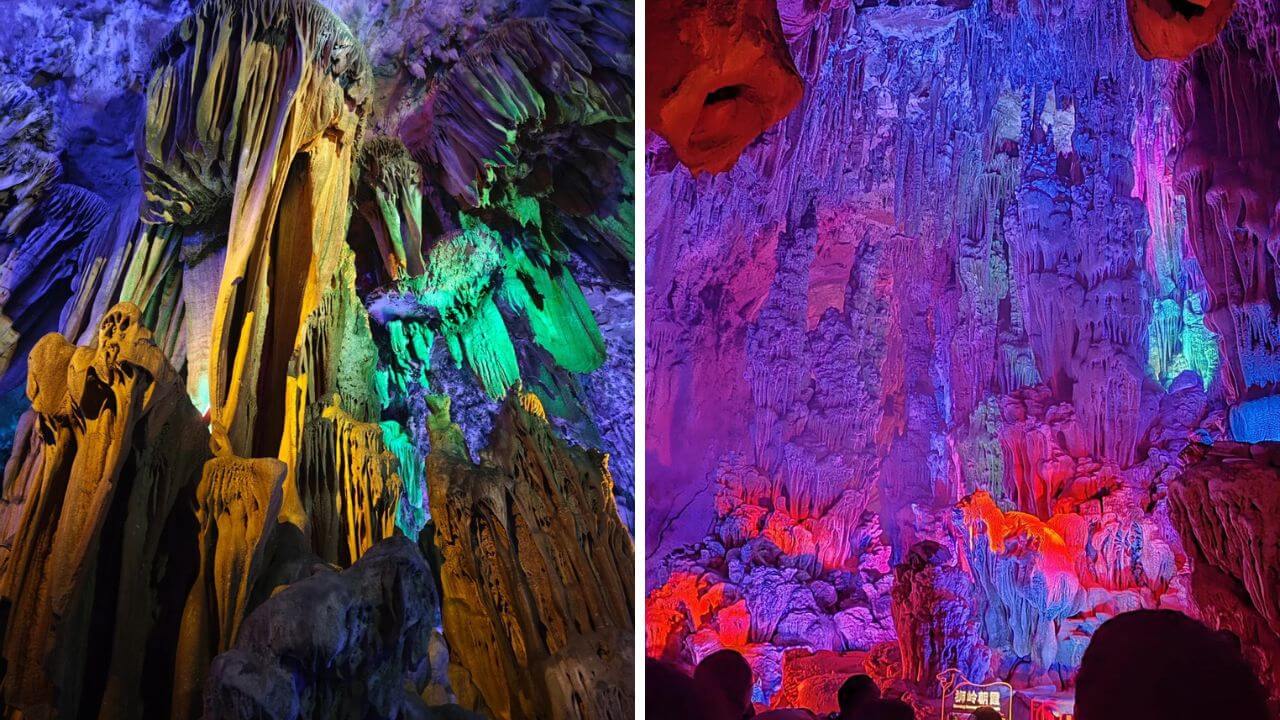
Tips for Visiting
Best Time to Visit– Reed Flute Cave can be visited year-round. However, visiting during the off-peak seasons (spring and autumn) can provide a more relaxed experience with fewer crowds.
Wear Comfortable Shoes– The cave tour involves walking on uneven and sometimes slippery surfaces. Comfortable and sturdy footwear is essential for navigating the cave safely.
Bring a Jacket- The temperature inside the cave can be cooler than outside, so it’s advisable to bring a light jacket or sweater to stay comfortable during your visit.
Respect the Environment– To help preserve the cave’s natural beauty, visitors should avoid touching the formations and follow all guidelines provided by the tour guides.
Plan for Limited Amenities– While basic amenities are available near the cave entrance, facilities inside the cave are limited. It’s a good idea to use restrooms and purchase any necessary items before entering the cave.
Consider a Tripod for Photography– For photography enthusiasts, bringing a tripod can help capture clearer and more stable images in the low-light conditions of the cave.
Elephant Trunk Hill
Elephant Trunk Hill, known as “Xiangbishan” in Chinese, is a prominent natural landmark located in Guilin, Guangxi Province, China. The hill is named for its striking resemblance to an elephant drinking water with its trunk extended into the Li River. This iconic formation is one of Guilin’s most famous attractions and a symbol of the city. Elephant Trunk Hill offers scenic beauty, historical sites, and cultural significance, making it a must-visit destination for tourists.
- Location: Guilin, Guangxi Province, China
- Height: Approximately 55 meters (180 feet)
- Age: Over 3.6 million years old
- Formation: Karst limestone
- Features: Elephant-like rock formation, Water Moon Cave, Puxian Pagoda
What you will see
Elephant Trunk Shape
The most significant about Elephant Trunk Hill is its shape, which resembles an elephant with its trunk dipping into the river. This natural formation is a stunning example of a karst landscape and has become a symbol of Guilin.
Water Moon Cave (Shuiyue Cave)
Located between the “trunk” and the “body” of the elephant, Water Moon Cave is a semi-submerged arch that reflects on the water, creating a moon-like image. The cave is adorned with ancient inscriptions and poems, adding to its cultural and historical appeal.
Puxian Pagoda
At the top of Elephant Trunk Hill stands the Puxian Pagoda, a small pagoda built during the Ming Dynasty. The pagoda is said to represent the handle of a sword carried by the elephant. Visitors can hike up to the pagoda for panoramic views of Guilin and the surrounding landscape.
Scenic Views
The area around Elephant Trunk Hill offers picturesque views of the Li River and Guilin’s unique karst landscape. The lush greenery and tranquil waters make it a perfect spot for photography and leisurely walks.
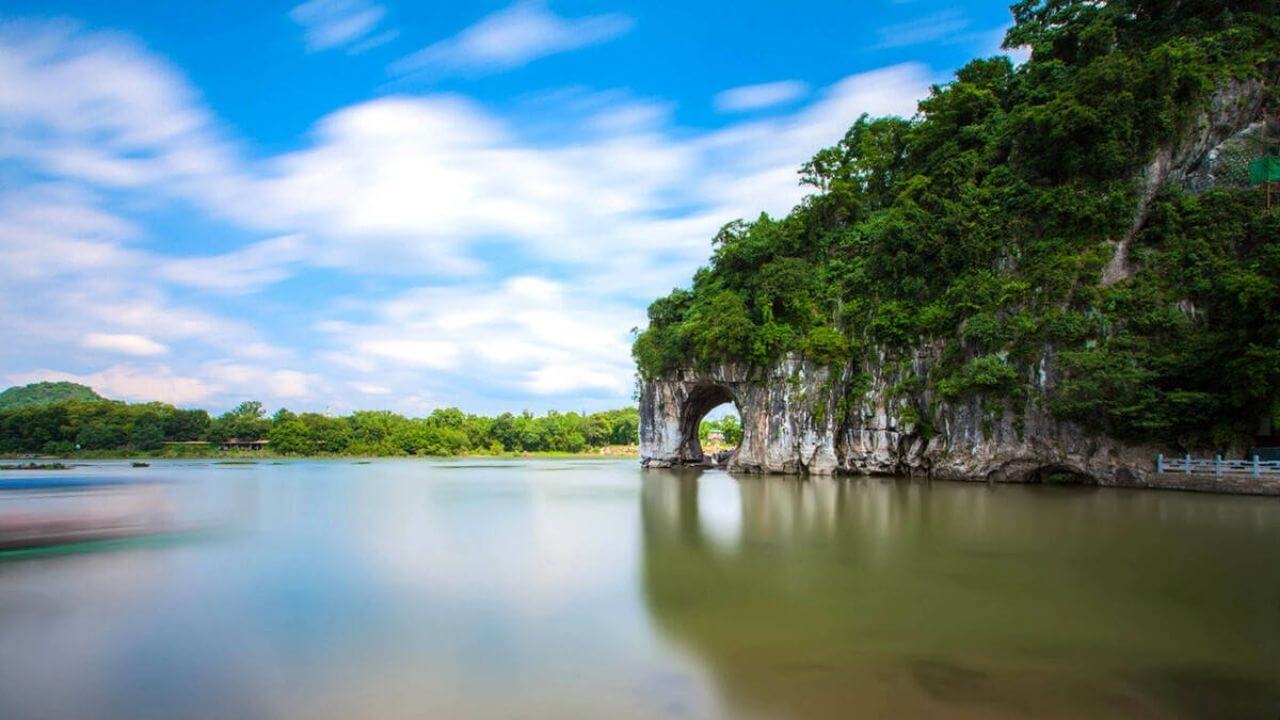
Historical and Cultural Significance
The hill and its surroundings have inspired poets, artists, and scholars for centuries. The inscriptions and carvings on the rock face provide a glimpse into the cultural and historical heritage of the region.
Boat Ride
Visitors can take a boat ride on the Li River to get a different perspective of Elephant Trunk Hill. The view from the water is particularly impressive and provides excellent photo opportunities.
Night Illumination
In the evening, Elephant Trunk Hill is beautifully illuminated, creating a magical atmosphere. The lights highlight the elephant shape and the reflections in the water, making it a popular time for visits and photos.
Tips from experienced guide
Best Time to Visit– The best times to visit are during the spring (April to June) and autumn (September to November). Early mornings and late afternoons are ideal for avoiding crowds and capturing the best light for photography.
Wear Comfortable Shoes– Comfortable footwear is recommended, especially if you plan to hike up to the Puxian Pagoda. The paths can be steep and uneven.
Bring a Camera– The stunning views and unique formations make Elephant Trunk Hill a photographer’s paradise. Don’t forget your camera to capture the beautiful scenery.
Stay Hydrated– Bring water, especially during the hotter months, as exploring the hill and its surroundings can be physically demanding.
Seven Star Park
Seven Star Park, also known as Qixing Park, is the largest and most comprehensive park in Guilin. It covering an area of approximately 120 hectares (297 acres), the park is named after the seven peaks that resemble the Big Dipper constellation. Seven Star Park
offers a blend of natural beauty, cultural relics, and recreational activities, making it a popular destination for both tourists and locals. The park is renowned for its picturesque landscapes, ancient caves, historical sites, and diverse flora and fauna.
- Location: Guilin, Guangxi Province, China
- Area: Approximately 120 hectares (297 acres)
- Named After: Seven peaks that resemble the Big Dipper constellation
- Key Features: Seven Star Cave, Camel Hill, Flower Bridge, Guihai Stele Forest, and more
- Established: Opened to the public in the 1940s
What to see
Seven Star Cave
One of the main attractions in the park, Seven Star Cave is a large limestone cave filled with impressive stalactites and stalagmites. The cave has been a tourist attraction for over 1,000 years and offers a fascinating underground exploration experience with colorful lighting enhancing the natural formations.
Camel Hill
Camel Hill, or Camel Mountain, is named for its resemblance to a resting camel. This unique karst formation is a popular spot for photography and provides a distinctive natural landmark within the park.
Flower Bridge
Flower Bridge, built during the Song Dynasty, is the oldest bridge in Guilin. It is beautifully adorned with flowers and offers a charming and scenic spot for visitors to enjoy views of the park’s waterways and lush surroundings.
Guihai Stele Forest
This area features a collection of ancient stone steles (inscribed tablets) dating back to the Tang and Song Dynasties. The inscriptions include poetry, calligraphy, and historical records, providing insight into the region’s cultural and literary heritage.
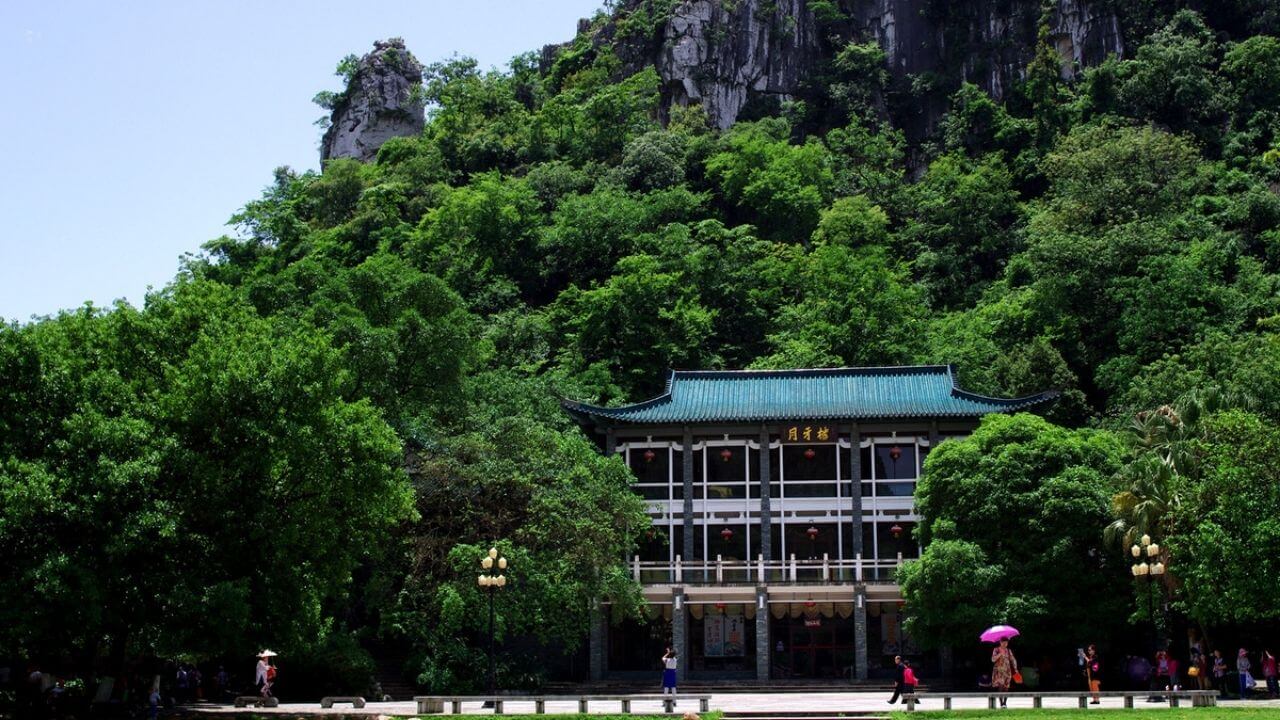
Seven Star Zoo
The park includes a small zoo that houses various animals, including pandas, tigers, and birds. It’s a family-friendly attraction, especially popular with children.
Crescent Mountain
Crescent Mountain offers hiking trails with panoramic views of Guilin and the surrounding landscape. The climb to the summit is rewarded with stunning vistas, making it a must-visit for nature lovers and outdoor enthusiasts.
Cultural and Historical Relics
The park is home to several cultural and historical relics, including temples, pavilions, and statues. Visitors can explore these sites to learn more about the rich history and cultural significance of the area.
Beautiful Gardens and Green Spaces
Seven Star Park features beautifully landscaped gardens, serene lakes, and abundant green spaces. It’s an ideal place for leisurely walks, picnics, and enjoying the natural beauty.
Tips for Visiting
Best Time to Visit– The best times to visit Seven Star Park are during the spring (April to June) and autumn (September to November) when the weather is pleasant, and the park’s flora is at its most vibrant.
Wear Comfortable Shoes– Comfortable footwear is essential as the park is extensive and involves a fair amount of walking, especially if you plan to explore the caves and hike the trails.
Bring a Camera– Be sure to bring a camera to capture the picturesque landscapes and attractions.
Plan Sufficient Time– Allocate several hours to explore the park thoroughly. There’s a lot to see and do, and you’ll want to take your time to enjoy each attraction.
Stay Hydrated and Bring Snacks– As I always tell to all my travelers, please stay hydrated, especially on summer days. There are vendors and small shops to buy snacks and water, but it’s a good idea to bring your own.
Respect the Environment– Help preserve the park’s natural beauty by not littering and following all posted guidelines and rules.
Visit Early or Late– If you want to avoid the peak crowds, consider visiting early in the morning or later in the afternoon. This will provide a more peaceful and enjoyable experience.
Fubo Hill
Fubo Hill is known for its stunning views and historical significance, it offers a blend of natural beauty and cultural heritage. The hill is home to ancient Buddha statues, carvings, and a pavilion offering panoramic views of Guilin.
- Location: Guilin, Guangxi Province
- Height: Approximately 63 meters (207 feet)
- Features: Unique rock formations, caves, ancient inscriptions, and panoramic views
- Name Origin: Named after General Fubo (Ma Yuan) of the Han Dynasty, who is said to have used the hill as a military training ground
- Key Attractions: Thousand-Buddha Cave, Returned Pearl Cave, Pavilion of Wind and Rain, and Sword-Testing Rock
What to visit
Thousand-Buddha Cave
One of the main attractions of Fubo Hill, the Thousand-Buddha Cave, is an ancient cave adorned with Buddhist carvings. Inside the cave, visitors can see over 200 Buddha statues and carvings from the Tang and Song Dynasties, showcasing the rich cultural and religious history of the area.
Returned Pearl Cave
The Returned Pearl Cave, located at the base of the hill, is another fascinating feature. The cave is known for its intriguing rock formations and ancient inscriptions. Legend has it that a pearl once fell into the cave and was later returned by a dragon, giving the cave its name.
Sword-Testing Rock
Sword-Testing Rock, also known as “Guqi Rock,” is a vertical rock slab that hangs from the ceiling of a cave. According to legend, General Fubo tested his sword by slicing through the rock, leaving a deep cleft. The rock is a testament to the area’s rich folklore and adds to the hill’s mystique.
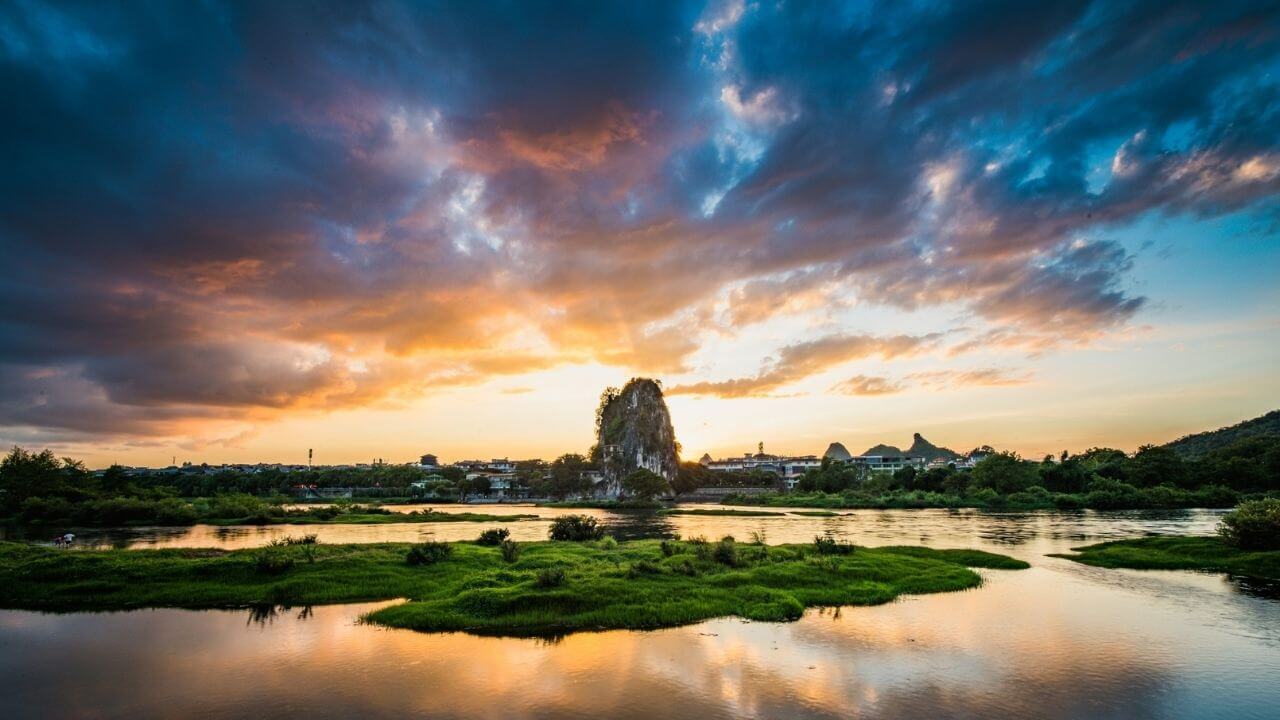
Pavilion of Wind and Rain
The Pavilion of Wind and Rain is located at the summit of Fubo Hill. This traditional Chinese pavilion offers a serene place to rest and take in the panoramic views of Guilin and the Li River. The ascent to the pavilion is rewarded with breathtaking vistas of the surrounding landscape.
Panoramic Views
Fubo Hill provides some of the best vantage points for panoramic views of Guilin. Visitors can enjoy stunning vistas of the city, the winding Li River, and the lush karst landscape. The hill’s height and location make it an ideal spot for photography and sightseeing.
Cultural and Historical Relics
The hill is home to numerous cultural relics, including ancient inscriptions and carvings that date back centuries. These historical elements add depth to the visitor experience, offering insights into the region’s past.
Tips for Visiting
Best Time to Visit: during the spring (April to June) and autumn (September to November).
Wear Comfortable Shoes: This is tip for every attraction that contains walk, hike or stairs.
Bring a Camera– The panoramic views from Fubo Hill are spectacular, making it a prime spot for photography. Be sure to bring a camera to capture the stunning scenery and unique features.
Visit Early or Late– To avoid the peak crowds and enjoy a more peaceful experience, best time of the day to visit is early in the morning or late in the afternoon. I always prefer early in the morning.
West Street (Xi Jie)
West Street, also known as Xi Jie, is the oldest and most famous street in Yangshuo, Guangxi Province. With a history of over 1,400 years, West Street is a vibrant and bustling hub of culture, commerce, and tourism. The street is renowned for its traditional architecture, lively atmosphere, and diverse blend of Eastern and Western influences, making it a must-visit destination for travelers exploring the picturesque region of Yangshuo.
- Location: Yangshuo, Guangxi Province
- Length: Approximately 800 meters (2,625 feet)
- History: Over 1,400 years old
- Features: Traditional architecture, shops, restaurants, bars, and cultural attractions
- Nickname: “Foreigners’ Street” due to its popularity with international tourists
What to Expect
Traditional and Modern Blend
West Street features well-preserved traditional Chinese architecture alongside modern shops, cafes, and bars. The unique blend of old and new creates a charming and eclectic atmosphere.
Shopping
The street is lined with a variety of shops selling local crafts, souvenirs, clothing, and antiques. Visitors can find handmade jewelry, calligraphy, silk products, and other unique items that reflect the local culture and craftsmanship.
Dining
West Street offers a diverse culinary experience with numerous restaurants and food stalls serving both local Chinese cuisine and international dishes. From traditional Guangxi specialties to Western favorites, there is something to satisfy every palate.
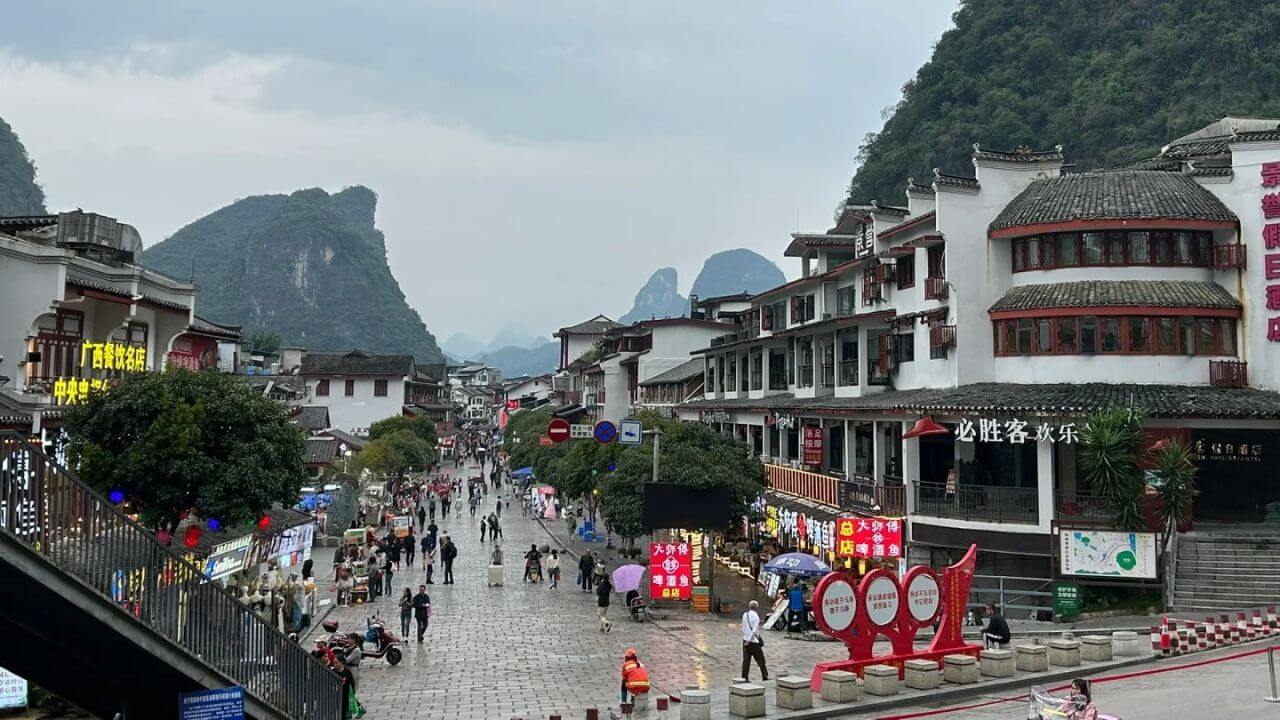
Nightlife
As the sun sets, West Street comes alive with vibrant nightlife. Bars, clubs, and live music venues create a lively and energetic atmosphere. It’s a great place to enjoy a night out, meet fellow travelers, and experience the local entertainment scene.
Cultural Attractions
The street hosts various cultural attractions and events, including traditional performances, art exhibitions, and festivals. These cultural experiences provide insight into the local traditions and heritage.
Relaxed and Friendly Vibe
West Street is known for its relaxed and friendly vibe, making it a popular spot for both locals and tourists. The welcoming atmosphere encourages visitors to stroll leisurely, shop, dine, and soak in the unique ambiance.
Tips
Best Time to Visit– The best time to visit West Street is during the evening when the street is most vibrant and the nightlife is in full swing. However, daytime visits offer a more relaxed experience for shopping and sightseeing.
Bargain When Shopping– Bargaining is common in the shops along West Street. Don’t hesitate to negotiate prices, especially when purchasing souvenirs and crafts.
Try Local Delicacies– Be sure to sample some local Guangxi delicacies, such as beer fish, rice noodles, and sticky rice cakes, to get a taste of the regional cuisine.
Stay Safe– While West Street is generally safe, it’s always wise to keep an eye on your belongings and be cautious in crowded areas, especially during the busy evening hours.
Go on Bamboo Rafting on the Yulong River
A more tranquil alternative to the Li River cruise, bamboo rafting on the Yulong River offers a peaceful journey through the countryside, passing by rice paddies, villages, and karst peaks.Bamboo rafting on the Yulong River is a popular and serene activity in Yangshuo. This tranquil and scenic journey allows visitors to experience the natural beauty of Yangshuo in a unique and relaxing way.
- Location: Yangshuo, Guangxi Province, China
- Length of the River: Approximately 35 kilometers (22 miles)
- Rafting Distance: Common routes range from 2 to 10 kilometers (1.2 to 6.2 miles)
- Duration: Rides typically last between 1 to 2 hours, depending on the chosen route
- Raft Material: Traditional bamboo rafts
Why to do it
Scenic Beauty– Bamboo rafting on the Yulong River offers unparalleled views of Yangshuo’s iconic karst landscape. The journey is filled with breathtaking scenes of limestone mountains, clear waters, and verdant fields.
Tranquil Experience– The Yulong River is less crowded than the Li River, providing a more peaceful and intimate experience. The gentle flow of the river and the absence of motorized boats ensure a quiet and relaxing ride.
Close to Nature– As you float down the river, you’ll be close to the water and the surrounding nature. You can see fish swimming in the clear river, birds flying overhead, and farmers working in the fields along the banks.
Local Culture– The rafting routes pass by traditional villages and ancient bridges, offering glimpses of rural life in Yangshuo. You might see locals fishing, farming, or going about their daily activities.
Photographic Opportunities– The serene journey provides numerous opportunities for photography. Capturing the dramatic karst peaks, reflections on the water, and idyllic rural scenes makes for memorable keepsakes of your visit.
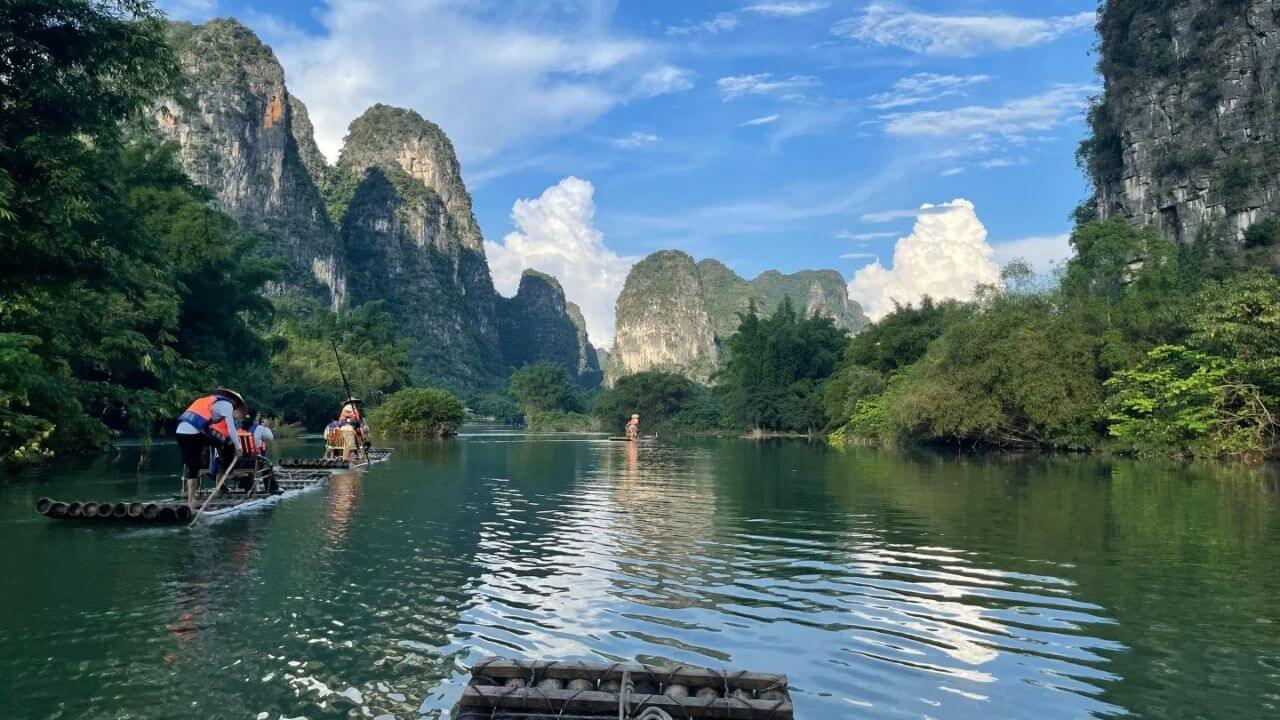
Tips for Visiting
Best Time to Visit:
- The best times for bamboo rafting on the Yulong River are during the spring (April to June) and autumn (September to November) when the weather is mild, and the scenery is lush. Early mornings and late afternoons offer the best light for photography and a more peaceful experience.
Dress Comfortably:
- Wear comfortable clothing and shoes suitable for a boat ride. It’s also a good idea to bring a hat, sunglasses, and sunscreen to protect against the sun.
Stay Hydrated:
- Bring water with you to stay hydrated during the ride, especially on hot days.
Protect Your Belongings:
- Use a waterproof bag or pouch to protect your valuables, such as cameras, phones, and wallets, from splashes or accidental dips in the water.
Respect Local Customs:
- Interact respectfully with the local boatmen and villagers. Tipping the boatman at the end of the ride is appreciated but not mandatory.
Book in Advance:
- During peak tourist seasons, it’s advisable to book your bamboo rafting trip in advance to secure a spot and avoid long waits.
Moon Hill
This famous karst peak features a natural arch at its summit, resembling a moon. Visitors can hike up to the arch for stunning views of the surrounding landscape.
Moon Hill, known as “Yueliang Shan” in Chinese, is one of Yangshuo’s most famous natural landmarks. Located a few kilometers south of Yangshuo town, in Guangxi Province, China, Moon Hill is named for the massive, moon-shaped hole that pierces its summit. This unique karst formation, combined with the stunning views from the top, makes Moon Hill a popular destination for hikers, photographers, and nature enthusiasts.
Facts
- Location: Yangshuo, Guangxi Province, China
- Height: Approximately 380 meters (1,247 feet) above sea level
- Hole Height: The arch is about 50 meters (164 feet) high and 50 meters (164 feet) wide
- Formation: Karst limestone
- Accessibility: 800 stone steps lead to the summit
What to Expect
Unique Karst Formation:
- The distinctive moon-shaped arch at the summit of Moon Hill is a striking example of the region’s karst landscape. The hole was formed by erosion, creating a natural arch that looks like a crescent moon when viewed from different angles.
Hiking Experience:
- Reaching the summit of Moon Hill involves a hike up 800 stone steps. The trail winds through lush greenery and offers beautiful views along the way. The hike is moderately challenging but manageable for most visitors.
Panoramic Views:
- At the top, hikers are rewarded with breathtaking panoramic views of the surrounding countryside, including the lush karst peaks, rice paddies, and winding rivers that make Yangshuo famous. The view from the summit is especially stunning at sunrise or sunset.

Rock Climbing:
- Moon Hill is also a popular spot for rock climbing. The overhanging arch provides several challenging routes that attract climbers from around the world. Climbing requires proper gear and experience, and local guides are available for those interested.
Photo Opportunities:
- The unique formation and scenic views make Moon Hill a prime location for photography. Whether capturing the moon-shaped arch from below or the expansive landscape from the summit, there are plenty of opportunities for stunning shots.
Local Vendors:
- Along the hiking path, local vendors sell refreshments, snacks, and souvenirs. These stops provide a chance to rest, hydrate, and buy local products.
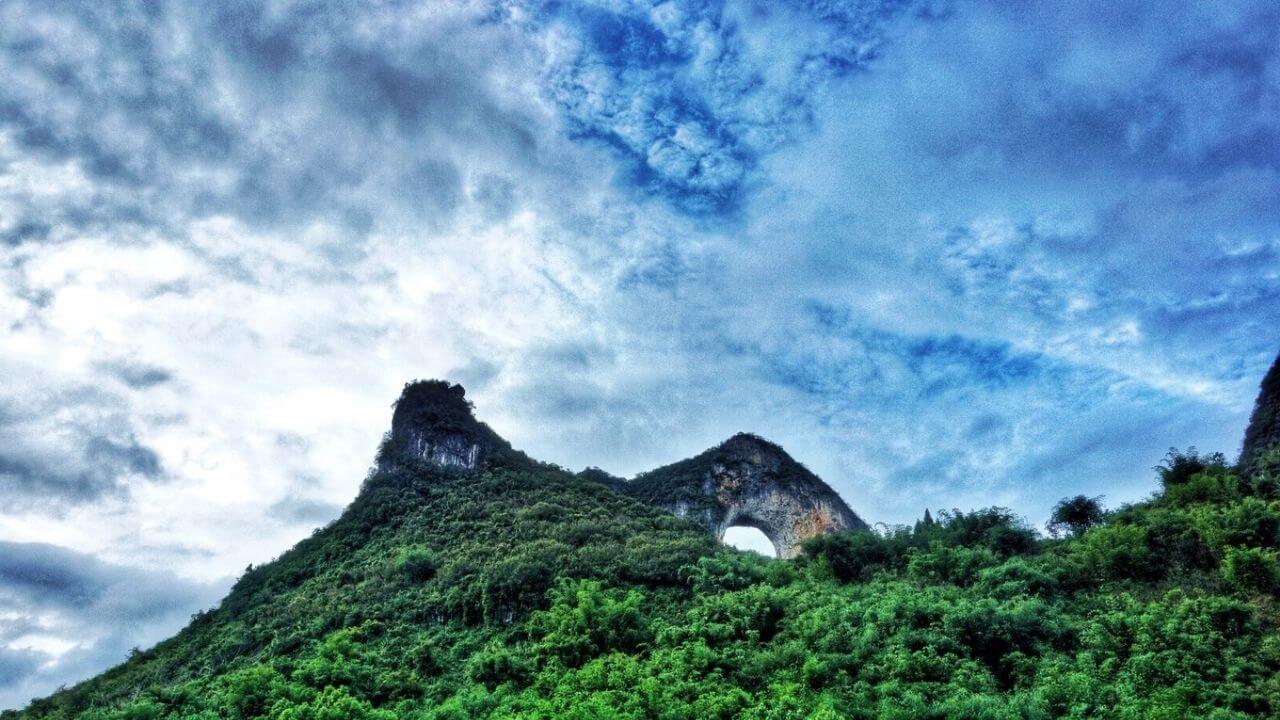
Tips for Visiting
Best Time to Visit:
- The best times to visit Moon Hill are during the spring (April to June) and autumn (September to November) when the weather is mild, and the scenery is lush. Early mornings and late afternoons are ideal for avoiding the heat and crowds.
Wear Comfortable Clothing and Footwear:
- Comfortable, sturdy shoes are essential for the hike up the stone steps. Lightweight, breathable clothing is recommended, and bringing a hat and sunglasses can help protect against the sun.
Stay Hydrated:
- Bring plenty of water, especially during warmer months. Local vendors along the path also sell drinks, but it’s good to have your supply.
Pace Yourself:
- The hike can be strenuous, especially in hot weather. Take your time, rest when needed, and enjoy the views along the way.
Bring a Camera:
- The unique natural arch and the views from the top offer excellent photo opportunities. Don’t forget to bring a camera or smartphone to capture the stunning scenery.
Respect the Environment:
- Help preserve the natural beauty of Moon Hill by not littering and staying on the designated paths. Respect any local guidelines and instructions from guides.
Climbing Gear:
- If you plan to rock climb, ensure you have the proper equipment and experience. Local climbing guides and equipment rentals are available for those interested in climbing the arch.
Cycling in the Countryside
Cycling through the countryside of Yangshuo offers an immersive experience in the heart of China’s picturesque rural landscapes. Travelers can expect to ride through lush rice paddies, alongside meandering rivers, and past towering karst peaks. The journey often includes encounters with local farmers, water buffalo, and traditional villages, providing a glimpse into the daily life and culture of the region.
What to Expect
- Scenic Beauty: Expect breathtaking views of karst mountains, serene rivers, and verdant fields. The natural beauty of Yangshuo’s countryside is a major highlight.
- Tranquility: The routes are generally peaceful, away from the hustle and bustle of city life, allowing for a relaxing and meditative ride.
- Local Interaction: Friendly locals and small villages along the way offer opportunities for cultural exchange and insight into rural Chinese life.
- Varied Terrain: The terrain can vary from flat paths to gentle slopes. Some areas might have more rugged trails, adding a bit of adventure.
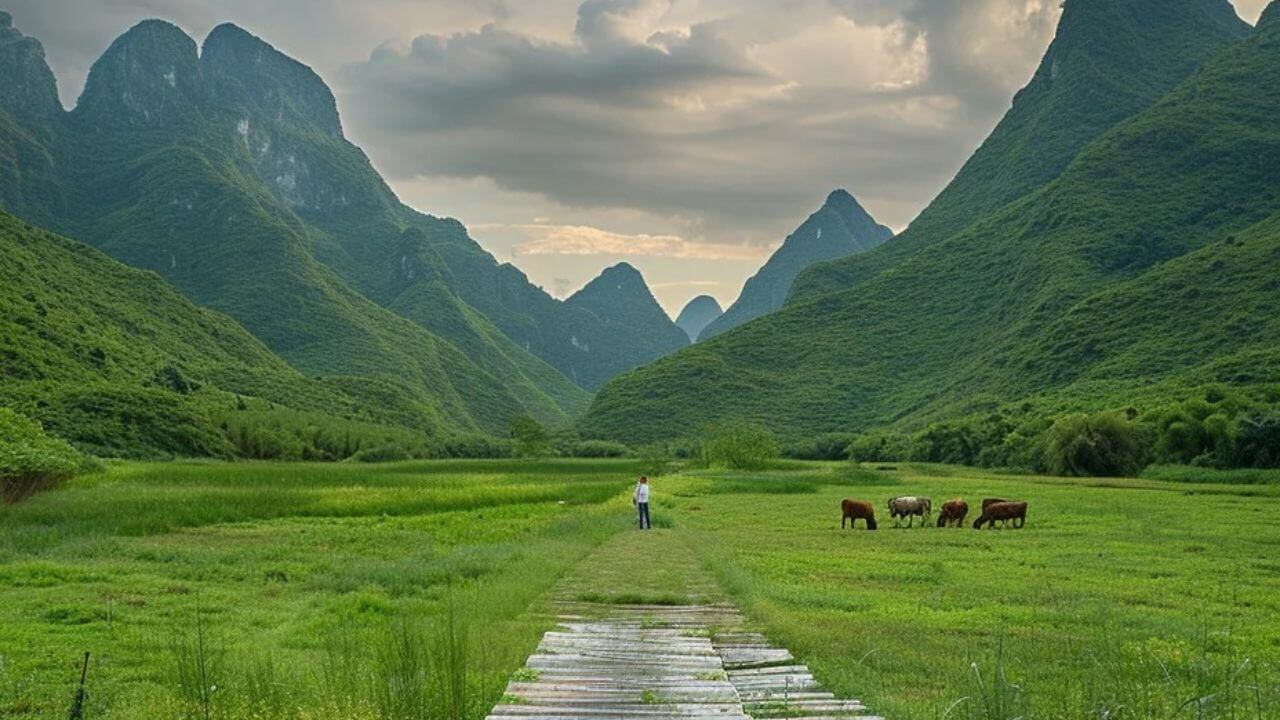
Who Can Do It
Cycling in Yangshuo’s countryside is suitable for most travelers, including:
- Families: Many routes are family-friendly, with relatively flat and safe paths.
- Beginners: There are easy trails suitable for those with little cycling experience.
- Experienced Cyclists: More challenging routes are available for those seeking an adventurous ride.
- Solo Travelers: It’s a safe and enjoyable activity for solo adventurers.
- Groups: Ideal for friends or tour groups looking for a shared experience.
Trails
Popular cycling routes in Yangshuo include:
- Yulong River Valley: A scenic and relatively flat route along the Yulong River, perfect for beginners and families.
- Moon Hill: A route that includes a visit to the famous Moon Hill, offering moderate challenges and stunning views.
- Dragon Bridge: This route takes you to the historic Dragon Bridge, passing through picturesque countryside and traditional villages.
Where to Book a Bike or Tour
- Bike Rentals: Bikes can be rented from numerous shops in Yangshuo town, especially around West Street. Most hotels and hostels also offer rental services.
- Guided Tours: Several local tour companies provide guided cycling tours, which can be booked online or through travel agencies in Yangshuo. These tours often include a knowledgeable guide, equipment rental, and sometimes meals or snacks.
- Recommended Tour Companies:
- Bike Asia: Offers a range of cycling tours catering to different skill levels.
- Yangshuo Mountain Retreat: Provides guided tours with an emphasis on eco-friendly and culturally immersive experiences.
- Bike Asia Adventures: Specializes in custom cycling tours tailored to individual preferences.
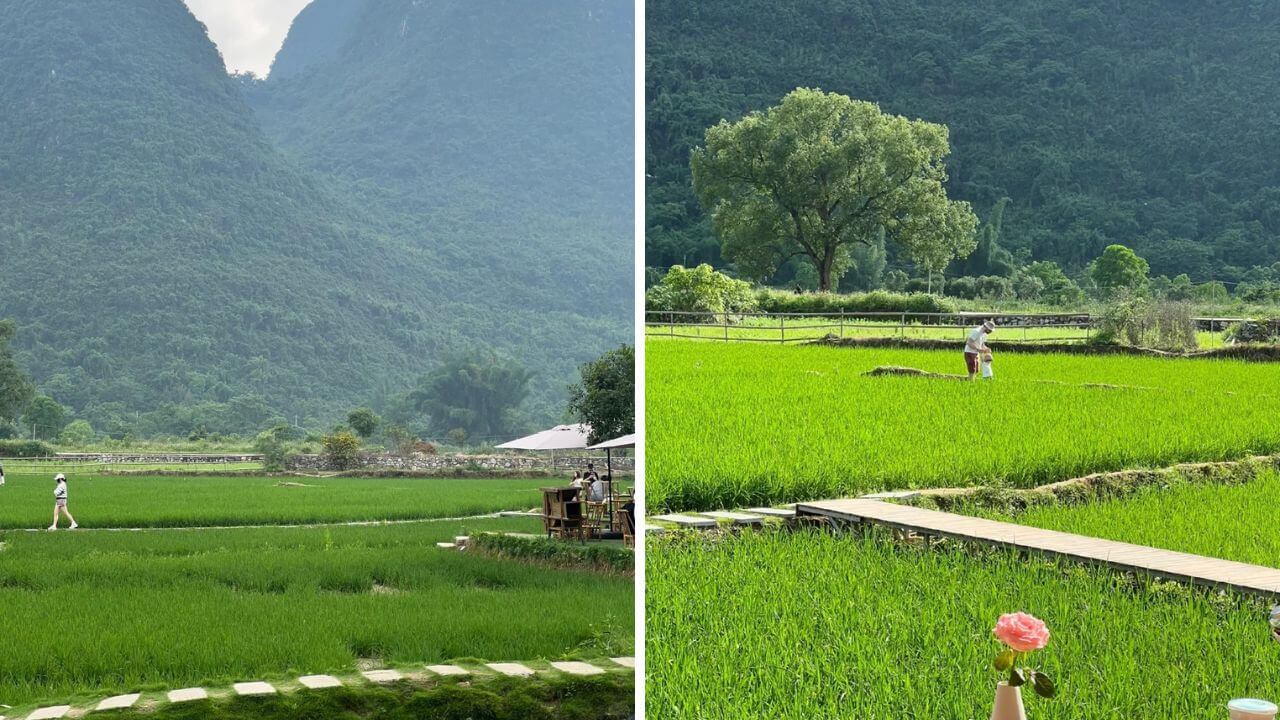
Tips
- Safety Gear: Always wear a helmet and consider bringing knee and elbow pads.
- Weather Check: Check the weather forecast before heading out and dress accordingly.
- Hydration and Snacks: Bring plenty of water and some snacks, especially for longer rides.
- Maps and Navigation: Carry a map or use a GPS device to stay on track. Some rental shops provide maps of popular routes.
- Respect Local Culture: Be respectful of local customs and traditions when passing through villages.
Impression Liu Sanjie Show
The Impression Liu Sanjie Show is a spectacular outdoor performance set on the Li River, using the natural karst mountains and water as the stage backdrop. Directed by the acclaimed Chinese filmmaker Zhang Yimou, the show is inspired by the legend of Liu Sanjie, a famous folk singer from the Zhuang ethnic minority. The performance combines traditional folk music, dance, and stunning visual effects to tell the story of Liu Sanjie’s life, her love, and her songs. It features over 600 performers, including local fishermen and ethnic minority villagers, creating an authentic and immersive cultural experience.
Reasons to attend to the show
- Unique Setting: The show takes place on the Li River, with the karst mountains illuminated to create a magical atmosphere. The natural scenery adds a breathtaking backdrop to the performance.
- Cultural Experience: The show offers a deep dive into the local culture and folklore of the Zhuang minority, showcasing traditional songs, dances, and customs.
- Visual Spectacle: The use of lights, sounds, and large-scale choreography makes the show a visual feast. The performers’ synchronization and the intricate design of the performance are captivating.
- Star-Studded Production: Directed by Zhang Yimou, known for his work on the Beijing Olympics opening ceremony, the show benefits from high production values and artistic excellence.
Best Time to See
The show is performed year-round, but the best time to see it is during the spring (April to June) and autumn (September to October) when the weather is most pleasant. Evening performances, which typically start at 7:30 PM or 8:00 PM, offer the best experience as the lights and natural setting are most striking after sunset.
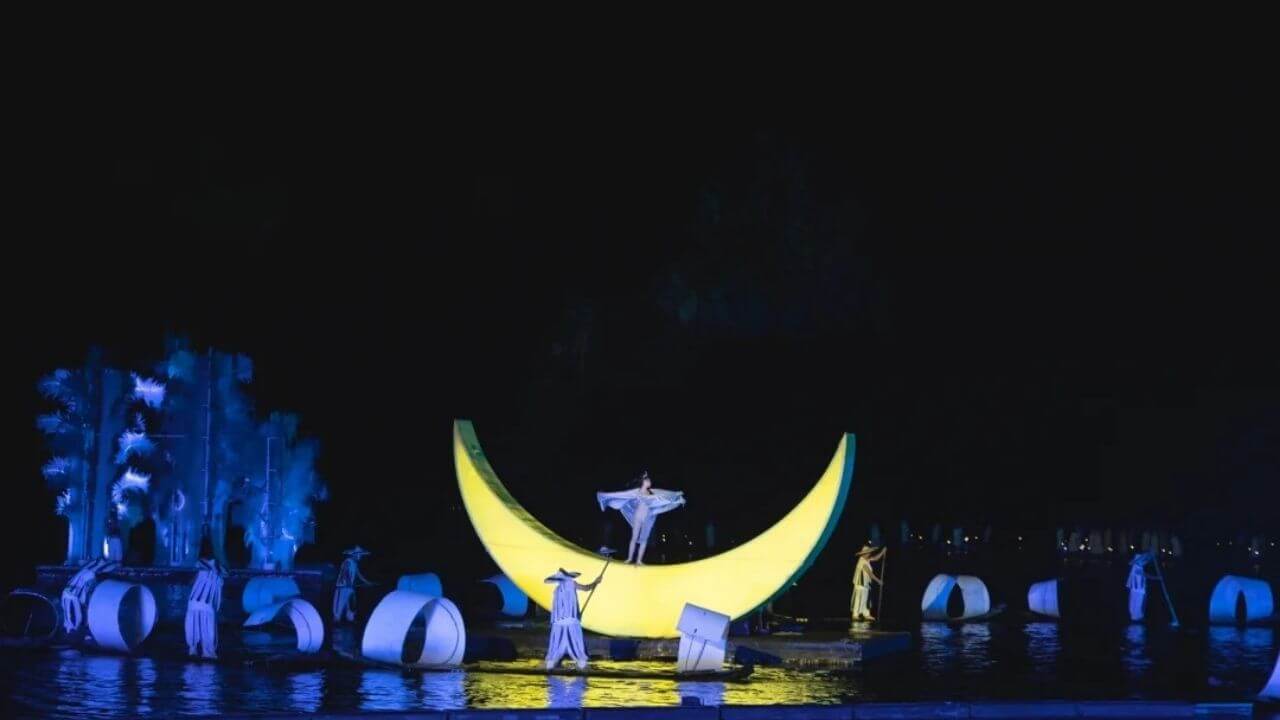
Where to Buy Tickets and Ticket Prices
- Online: Tickets can be purchased online through various travel websites and platforms like Trip.com, Viator, and official sites dedicated to the show.
- Local Agencies: Many travel agencies in Guilin and Yangshuo sell tickets, often as part of a package deal including transportation.
- Hotels and Hostels: Most accommodations in Yangshuo can arrange tickets for guests, often at competitive prices.
- At the Venue: Tickets can be bought directly at the show’s venue in Yangshuo, but it is advisable to book in advance during peak tourist seasons to ensure availability.
Ticket prices vary depending on the seating category:
- VIP Seats: Approximately 680-880 CNY ($100-$130 USD), offering the best views and comfort.
- A-Class Seats: Around 480-680 CNY ($70-$100 USD), providing excellent views.
- B-Class Seats: About 320-480 CNY ($50-$70 USD), offering good views but further from the stage.
- C-Class Seats: Approximately 198-320 CNY ($30-$50 USD), providing a more budget-friendly option with decent views.
Prices may vary slightly based on the season and demand. It’s best to check current rates online or through local agencies.
Tips for Attending
- Arrive Early: Arrive at least 30 minutes before the show starts to find your seat and settle in.
- Dress Comfortably: The show is outdoors, so dress appropriately for the weather and bring a light jacket for cooler evenings.
- Photography: While photography is allowed, be mindful of other audience members and the performers.
Silver Cave
Silver Cave is one of the region’s most spectacular karst caves. Renowned for its stunning underground landscapes, the cave features a dazzling array of stalactites, stalagmites, and rock formations. The cave is named for the silver-like shimmer that its formations exhibit when illuminated by artificial lights, creating a magical and otherworldly atmosphere. Silver Cave is a popular tourist attraction, offering visitors a chance to explore the geological wonders beneath the earth’s surface.
- Location: Lipu County, near Yangshuo, Guangxi Province, China
- Length: Approximately 2 kilometers (1.2 miles)
- Depth: Extends across three main layers, reaching up to 10 kilometers (6.2 miles) in depth
- Features: Stalactites, stalagmites, stone curtains, and other unique formations
- Illumination: Colorful artificial lighting highlights the cave’s natural beauty
What to Expect
Stunning Rock Formations:
Silver Cave is filled with an impressive variety of rock formations, including stalactites hanging from the ceiling, stalagmites rising from the ground, and intricate stone curtains. These formations have developed over millions of years and are beautifully illuminated to enhance their natural beauty.
Colorful Lighting:
The cave is artfully lit with multicolored lights that highlight the unique features of the formations. The lighting creates a surreal and enchanting atmosphere, making the cave appear almost magical.
Scenic Sections:
The cave is divided into three main sections: the upper cave, the grand hall, and the lower cave. Each section offers different features and highlights, such as the “Snowy Mountain with Waterfall,” “Music Stone Screen,” and “Deep Moon Palace.”
Photography Opportunities:
The dramatic lighting and unique formations provide excellent opportunities for photography. Visitors can capture the mesmerizing beauty of the cave’s interior, with its shimmering walls and intricate structures.
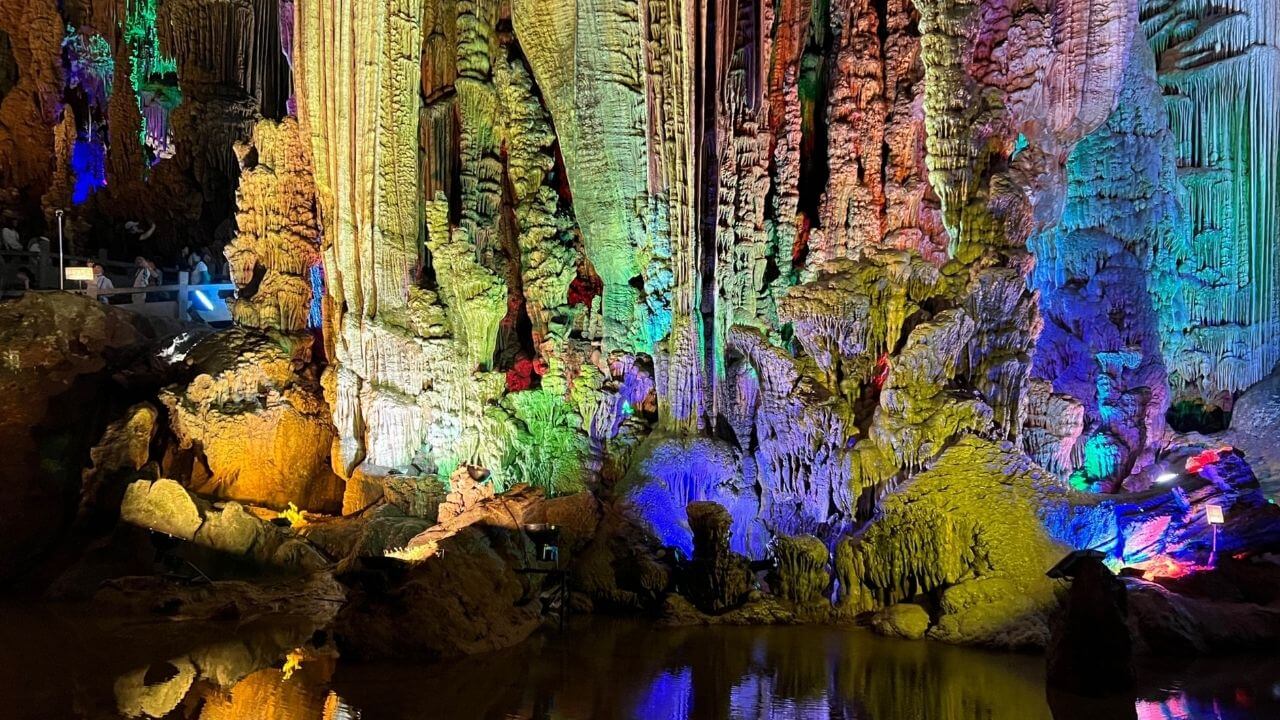
Guided Tours
Guided tours are available and recommended for a more informative experience. Knowledgeable guides explain the geological history of the cave, the formation of its structures, and the significance of its various sections.
Accessibility:
The cave is equipped with well-maintained walkways and steps, making it accessible to most visitors. However, comfortable footwear is recommended due to the uneven and sometimes slippery surfaces.
Cultural and Historical Significance:
In addition to its natural beauty, Silver Cave holds cultural and historical significance. The cave has been a source of inspiration for poets and artists over the centuries, and its formations are often associated with various legends and stories.
Tips
Best Time to Visit:
- Silver Cave can be visited year-round. However, the best times are during the spring (April to June) and autumn (September to November) when the weather is mild and the surrounding scenery is at its most beautiful.
Wear Comfortable Shoes:
- Comfortable, sturdy shoes are essential for exploring the cave. The paths can be uneven and slippery, so proper footwear is necessary for safety.
Bring a Camera:
- The unique formations and colorful lighting make Silver Cave a photographer’s paradise. Don’t forget to bring a camera or smartphone to capture the stunning views.
Join a Guided Tour:
- Consider joining a guided tour to gain deeper insights into the cave’s geological features and history. Guides provide valuable information that enhances the overall experience.
Combine with Nearby Attractions:
- Silver Cave is located near other popular attractions in Yangshuo and Lipu County. Consider combining your visit with a trip to Moon Hill, the Yulong River, or other scenic spots to make the most of your trip.

Helen Wang
Travel Advisor & Guide Expert
I started my travel career in 2005 and have since become an expert in Tibet and China’s travel destinations and helping travelers plan unforgettable trips.
For expert travel advice to China or Tibet, feel free to contact me.